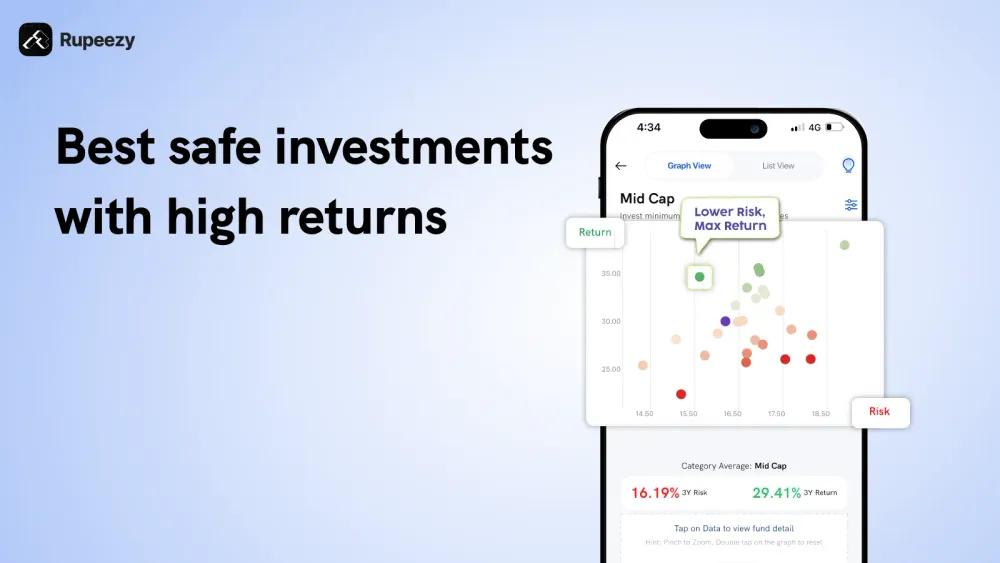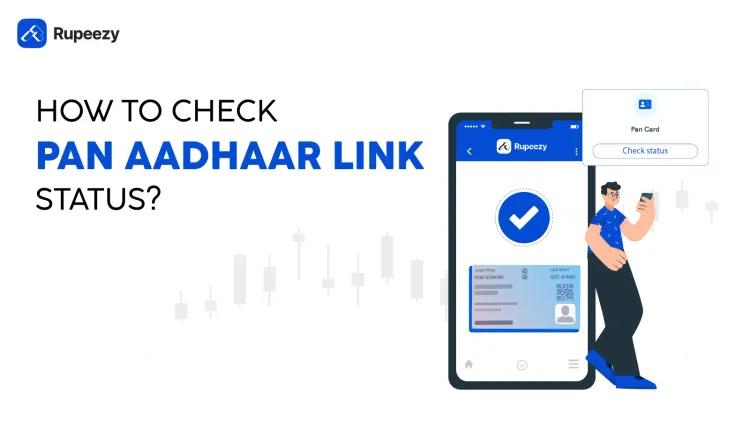Best Safe Investments with High Returns in India 2025


00:00 / 00:00
In the era of market volatility and inflation, the first priority of investors is capital safety and stable returns. In such a situation, people are looking for options that can give better returns with less risk. This is the reason why safe investments with high returns in India have become an important topic today. In this article, we will talk about such reliable and safe investment options, which not only keep your money safe but also provide an opportunity for stable earnings over time.
What Makes an Investment Safe?
Every investor wants their money to be safe and the returns on it to be reliable. But to decide how safe any investment is, it is important to understand some important things.
Capital Protection: The safest investment is the one in which there is no risk to your principal amount deposited. For example, in Public Provident Fund (PPF) and RBI Bonds, your capital is completely safe because they are guaranteed by the government.
Guaranteed returns and government support: In government-backed schemes such as SCSS, NSC, or POMIS, you get a predetermined interest rate. It is not affected by market fluctuations, so these can also be called risk-free investments.
Lock-in period and liquidity: Sometimes, the investment may be safe, but the money remains stuck in it. For example, the lock-in period of PPF is 15 years. Therefore, before investing, definitely check its liquidity, i.e., the facility of withdrawing money when needed.
Fixed vs Market Linked: Schemes like FD, PPF, and SCSS offer fixed returns, while options like mutual funds are market-linked. Many investors invest in ULIPs or chit funds, thinking they are low-risk risk high-return investments, which later turn into losses.
So, it is very important to understand the credit rating, guarantee, interest rate, tax benefits, and withdrawal facility of any investment before considering it safe. Only then will you be able to keep your money safe in the true sense?
List of Safe Investments with High Returns in India
Here’s a curated list of safe investment options in India that offer attractive returns:
Investment Options | Estimated Returns (FY25) | Lock-in period | Tax benefit | Risk Level |
Public Provident Fund (PPF) | 7.1% | 15 years | EEE (Completely Tax-Free) | Very little |
Senior Citizen Savings Scheme (SCSS) | 8.2% | 5 years | Section 80C + Interest Taxable | Very Low |
RBI Floating Rate Savings Bonds | 8.05% | 7 years | Interest Taxable | Very Low |
Post Office Monthly Income Scheme | 7.4% | 5 years | Interest Taxable | Low |
National Savings Certificate (NSC) | 7.7% | 5 years | Section 80C Deduction | Very Low |
Tax-Free PSU Bonds | 5.5% – 6.5% | 10–20 years | Interest Fully Tax-Free | Low |
AAA-Rated Bank Fixed Deposits | 6.5% – 8.25% | 1–5 years (Flexible) | Interest Taxable | Low |
Target Maturity Funds (TMFs) | 7.2% – 7.6% | 5–10 years | LTCG Benefit | Low |
Low Duration Debt Mutual Funds | 6.5% – 7.5% | No lock-in | Indexation Benefit (after 3 yrs) | Low |
Sukanya Samriddhi Yojana (SSY) | 8.2% | 21 years (Partial exit allowed) | EEE (Tax-Free for girl child) | Very Low |
Overview of Safe Investment Options in India
Here is the detailed overview of risk free investment options in India, outlining returns, investment tenure, and appropriate investor segments.
1. Public Provident Fund (PPF):
PPF is a safe and tax-free long-term investment scheme, which is run by the government. The interest rate available in this is 7.1% per annum (Q2 FY25), which is completely tax-free. The biggest feature of this scheme is its compounding model, which makes your money grow rapidly over time. It is ideal for those who want to save for long-term goals like retirement, children's education, or marriage. Investing in it is very easy and you can open it in both a bank or post office. This scheme is for those investors who want to build a strong fund in the long term without risk.
2. Senior Citizen Savings Scheme (SCSS):
SCSS is exclusively for senior citizens above 60 years of age. The interest rate available in this is 8.2% per annum (Q2 FY25), which comes to the investor's account on a quarterly basis. This scheme is backed by the government, so there is no risk of capital. By investing in it once, a person can get regular income every three months, which is very beneficial for expenses after retirement. The maximum investment limit has been increased to Rs. 30 lakh so that even a large amount can be invested safely. Tax exemption is also available, making this scheme a great option for retired people.
3. RBI Floating Rate Savings Bonds:
This bond issued by the RBI is a floating return investment, which currently pays 8.05% per annum (July–Dec 2025). Its interest is reset every 6 months based on the NSC rate, due to which the return changes according to the market rates. It is best for those who want better interest rates with a government guarantee. Although its lock-in period is 7 years and withdrawal before maturity is not possible, its security and stability make it a reliable option. Interest comes directly into the bank account and it can be purchased completely digitally.
4. Post Office Monthly Income Scheme (POMIS):
POMIS is for those who want a stable income every month, like retired people or housewives. The current interest rate in this scheme is 7.4% per annum (Q2 FY25), which is credited to your account on a monthly basis. This scheme is run by the post office and has almost no risk. Its investment period is 5 years, and a maximum of Rs. 9 lakh (single) and Rs. 15 lakh (joint) can be invested. Interest is taxable but the capital is completely safe. This is an excellent option for those who want regular income for monthly expenses.
5. National Savings Certificate (NSC):
NSC is a fixed-return investment scheme that you can buy from the nearest post office. The current interest rate in this is 7.7% per annum (Q2 FY25), which remains fixed for five years and is compounded annually. This scheme is ideal for small and middle-class investors who want to grow their money over a period of time without any risk. The interest on this scheme is paid on maturity and it also offers tax exemption up to Rs 1.5 lakh (under section 80C). If you want a systematic and safe investment, then this is an effective option.
6. Tax-Free PSU Bonds:
Tax-Free PSU Bonds are issued by government public sector utilities (PSUs), and the interest on these is tax-free at 5.5%–6.5%. These are usually available with a tenure of 10–20 years. If you are looking to invest money for the long term and do not want to be tax-free on the interest, then this is an excellent option. These are backed by companies with a credit rating of AA or AAA, so capital safety is ensured. Though they have less flexibility in terms of withdrawal, they are a favorite for retirement planning or those looking for a stable income due to tax-free returns.
7. AAA-Rated Bank Fixed Deposits (FDs):
FDs in AAA-rated banks and reputed NBFCs currently offer interest rates of 6.5%–8.25%. Senior citizens get additional benefits (floor rate). Your capital is insured by DICGC up to Rs. 5 lakh, making the risk negligible. The tenure is usually 1–5 years, and there is a turn-in option in the middle for withdrawal. Simple, transparent, and bank trust have made FDs a popular option, especially for those who avoid digital investments and want traditional returns.
8. Target Maturity Funds (TMFs):
TMFs are debt funds that offer investors fixed returns with the maturity date of the bond. For example, schemes like BHARAT Bond FOF—April 2031 have been offering around 10.9% annualized returns (on a 1-year basis) recently. These invest in G-Secs and PSU bonds and mature on a specified date. If you are looking for a safe investment with a 5–10-year horizon and want to avoid market-linked fluctuations, TMFs are a very convenient option. Also, they can be bought both as a SIP or as a lump sum.
9. Low-Duration Debt Mutual Funds:
These funds invest for a period of 6–12 months and have a current 1-year average return of 8.5% (till June 2025). Managed by large AMCs like HDFC, ICICI, and SBI, these funds are relatively stable and have better returns as per analysis. There is no lock-in; hence, the amount can be withdrawn whenever required. At the tax level, holding for more than 3 years offers indexation benefits under LTCG. If you are looking for slightly better returns at lower risk, these are suitable for you.
10. Sukanya Samriddhi Yojana (SSY):
The aim of the Sukanya Samriddhi Yojana (SSY) is to create a safe and long-term fund for the daughter's future. It gives 8.2% annual interest (Q2 FY25). It can be opened up to 10 years from the birth of the daughter, and the deposit amount is completely tax-free (EEE status). The total tenure is 21 years, but partial withdrawal is also allowed after the daughter's 18th birthday or 10th class. The minimum investment possible is Rs. 250, and the maximum is Rs. 1.5 lakh per year. This scheme proves to be a reliable tool for girl child education, marriage, or higher education.
Factors to Consider Before Choosing Safe Investment Options in India
Whenever you choose a safe investment option in India, just looking at the interest rate or tax benefits is not enough. The right investment means choosing the right scheme according to your needs, goals, and risk profile. Below are some important points that are very important to pay attention to before making a decision:
Investment Horizon: Every scheme has a period – some are for 1–3 years and some for 15–20 years. If your goal is long-term (like retirement), then PPF or TMF is good. For the short term, FD or Debt Fund may be better.
Liquidity Requirement: Do you need the facility to withdraw money when needed? If yes, then choose schemes in which quick withdrawal is possible – like Fixed Deposit, Debt Mutual Funds, or POMIS. Options like PPF or SSY are less liquid.
Tax Implications: Whether the interest on each scheme is taxable or tax-free, it has a direct impact on your returns. For example, PPF and SSY are completely tax-free, while interest on FD or SCSS is taxable.
Expected Returns vs Inflation: No matter how much the interest rate is, if it is less than inflation, then the real benefit will not be there. Always choose options that also give better inflation-adjusted returns, like Target Maturity Funds or Debt Mutual Funds.
Personal Financial Goals: Every investment is for some purpose – children's education, marriage, buying a house, or retirement. It is important to choose a scheme according to these goals. PPF or TMF can be a better option for long-term plans, and FD or SCSS can be a better option for short-term needs.
How to Maximize Returns on Risk Free Investment Options
Just investing is not enough; if you want to get better returns from your safe investments, then it is important to adopt some smart strategies. Below are some simple but effective ways to make the most of low-risk investment options:
Balance different options: Build a portfolio by combining investments like PPF, SCSS, and Target Maturity Funds. This will not only reduce the risk, but you will get both tax savings and returns.
Adopt FD Laddering: Instead of making a large FD at one time, divide it into different periods (eg 1, 2, 3 years). This will ensure that one FD matures every year, and you will get better average returns along with liquidity.
Choose tax-wise options: If you fall in the high tax slab, give preference to PPF, SSY, or tax-free bonds. This will increase the net return.
Keep an eye on the interest rate cycle: Understand the interest rate trend before investing in TMFs or RBI Bonds. Investing is more profitable when rates are high.
Avoid frequent withdrawals: The benefit of compounding in safe investments is available only when you invest regularly and avoid withdrawals. This is what creates big returns in the long term.
Risk Free Investment Scams to Avoid
Whenever you look for safe investments with high returns in India, many times such fake schemes also come up which lure people by promising high returns. Below are some common mistakes and tips to avoid fraud:
Stay away from “Guaranteed 10%+ Return” scams: If a scheme is claiming a guaranteed return of 10% or more, be cautious. Safe investment options in India usually give returns of 6%–8.5% only. Claims of high returns are often fake.
Avoid unregistered chit funds and MLM: Platforms that are not registered with SEBI or RBI, such as local chit funds, MLM plans, or some fake NBFCs, can put your capital at risk.
Verify before investing: Before choosing any scheme, check its validity with the RBI, SEBI, AMFI, or government portals. You can also check the company's CIN number on the MCA website.
Do not trust WhatsApp/SMS tips: If someone suggests an investment from an unknown number, ignore it. Such groups or calls can lead to a loss of investment.
Avoid plans that promise quick doubling of money: The most common fraud trick is the “double your money in 3 years” promise. Only Ponzi schemes make such claims and the risk of losing money in them is very high.
Read the written documents and T&Cs: Many investors sign the documents without reading them. Carefully understand the rules, withdrawal conditions, tax rules, and charges of each scheme.
Conclusion
Safe investment does not only mean the safety of capital but also getting stable returns and financial freedom by choosing the right plan. There are many safe investment options with high returns available in India, which can work according to your needs, period, and tax status. But proper research and caution are very important. Remember there is security in stability.
FAQs
Q1. What is the safest investment option in India in 2025?
PPF, SCSS, and Sukanya Yojana are considered the safest investment options in India.
Q2. Which investment gives high returns with low risk?
Target Maturity Funds and RBI Floating Bonds give better returns with low risk.
Q3. Can I invest in multiple safe options together?
Yes, you can invest in multiple safe options simultaneously to diversify the portfolio.
Q4. Are tax-free bonds better than FDs?
If you are in a high tax slab, tax-free bonds may be a better option than FDs.
Q5. How do I check if an investment scheme is genuine?
Check the registration status of the company on the RBI, SEBI, or MCA website.
Q6. Is there any monthly income-safe scheme?
Yes, Post Office MIS and SCSS are safe options for monthly income.
Check Out These Related Articles |
The content on this blog is for educational purposes only and should not be considered investment advice. While we strive for accuracy, some information may contain errors or delays in updates.
Mentions of stocks or investment products are solely for informational purposes and do not constitute recommendations. Investors should conduct their own research before making any decisions.
Investing in financial markets are subject to market risks, and past performance does not guarantee future results. It is advisable to consult a qualified financial professional, review official documents, and verify information independently before making investment decisions.

All Category










